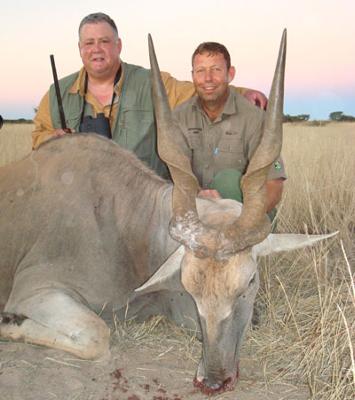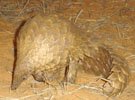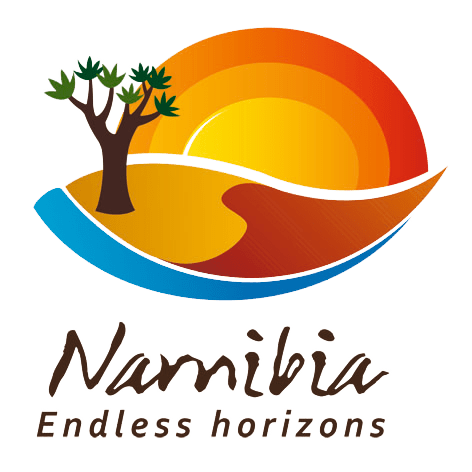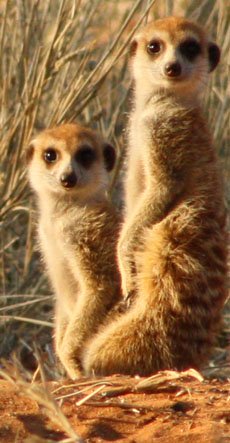For more information about our hunting safaris, don’t hesitate to reach out and contact us!
The Blue Bulls From Botswana
by Stephan Hofmann
(Illinois)
I agonized over what rifle to take for the Eland. I had a Ruger "African" .375 Ruger which would surely do the job but this rifle had an excessive amount of recoil. I finally decided on my trustworthy Ruger M77 .300 Win Mag. The .300 Win Mag would allow my to take many of the smaller animals besides the mighty Eland with reduced recoil.
In May of 2009 I was met at the Windhoek Airport and escorted to Uitspan by Michael and his wife, Tienie. After such a long period of correspondence it was wonderful to actually meet the Duvenhage's. I also met young Jan-Hendrik, little Isabelle and later on I met eleven year old Maria. They are exceptionally bright and beautiful children.
When I arrived at the hunting camp about 450 yards from the Botswana border, I unpacked and had a cold glass of borehole water from deep beneath the Kalahari sands.
Michael said it was time to go to the rifle range and see if I could shoot. I was eager to pull the trigger on my rifle. We went to a large pan which is a flat area that fills with water during the rainy season. The pan was dry at this time of year. The pan serves as a rifle range and an airfield for small planes that bring hunters to Uitspan.
There was a small cornfield by the side of the pan which Michael said was used by Eland. Across the pan, perhaps one thousand yards away, was a waterhole. Michael spotted a herd of Eland at the waterhole. There was also a herd of Gemsbok. The herd of Gemsbok quickly ran off into the hills surrounding the pan. The Eland remained.
Michael said the Eland herd consisted of about five cows and three big bulls. He said the bulls had come from Botswana and he had seen them frequently by the pan eating corn. Two of the bulls were very nice, indeed, but it was a large blue colored bull with a massive dewlap that almost dragged on the ground that Michael pointed out to me.
I assured Michael that my rifle was sighted in properly. I wanted to go after the blue bull. Michael said that we could attempt a stalk even though there was not much vegetation to hide behind.
Michael said to follow him closely and remain in his shadow as we approached the bull. He said the bull was waiting for the cows to go to the corn. The blue bull kept walking back and forth waiting for the cows. The sun was setting. We only had about an hour of daylight left. We approached to 750 yards of the blue bull. We started to move to the left to gain the concealment of a large Acacia Tree. We crouched by the tree about 350 yards from the blue bull. It was becoming dark. My scope picked up a lot of light. I could see the blue bull in my crosshairs but the distance was too great to try a shot. We crouch-walked another 150 yards. The blue bull disappeared in the trees and our exciting stalk was over.
Michael shook my hand and said he would always remember the stalk over barren ground. We went to the camp and met Hendrik snr and Michael's brother-in-law, Neil. We had a cold Windhoek Lager while sitting by the large firepit. We had Kudu steaks for supper. Micheal said we would search for the Eland herd tomorrow.
I slept well in my luxurious accommodations and dreamed of Eland with large horns and large dewlaps. I awoke the next morning to the sound of Michael crowing like a Rooster. Then I had biscuit and tea for breakfast.
We started out that day looking for Eland but ran into a herd of Gemsbok. I harvested a 40.5 inch female Gemsbok, a true Kalahari trophy.
That night we had Gemsbok steaks for supper. In the morning we would once again hunt Eland.
The next morning was a bit chilly. I awoke to the sound of the Rooster and had biscuit and tea with cream. Hendrik called and said he had seen a nice Eland. We found the tracks of the Eland in the red Kalahari sand and followed them. During the hunt we saw many animals including Kudu, Gemsbok, small Eland and Giraffe. The Kalahari is a paradise with it's wealth of wild animals.
We followed the Eland tracks for miles. Then, we got very close. The Eland bull; not the blue bull, came out of the trees on the right at a gallop. I executed a running shot and shattered the bull's hip. The bull slowed down and I put the finishing shot into him.
He was a magnificent bull. He was in his prime. His horns measured 39.5 inches with an overall score of 262cm. 210cm is Namibian Gold so you can see that this was an exceptional animal; one of the top 20 from Namibia for all time.
There had been a full moon the last few nights. Tienie said that they enjoy the marrow from animals in the Kalahari. She said that the marrow is best during a full moon. That night we roasted the marrow bones from the Eland on the fire. Tienie stuffed a marrow and garlic mixture into the large Eland tenderloins. The tenderloins were roasted over the fire.
Nothing can beat a cold Windhoek Beer enjoyed with good friends sitting by a Camelthorn fire and eating Eland tenderloin and marrow.
I was very happy. I had just experienced a wonderful hunt with great people in a beautiful land. I was content.
Stephan Hofmann
Comments for The Blue Bulls From Botswana
|
||
|
||
|
||
|
||
|
||
|
||
|
||
|
||
Meaning of "Uitspan"
'Uitspan' is an Afrikaans word that means place of rest.
When the Boer settlers moved inland in Southern Africa in the 1800's, they used ox carts. When they found a spot with game, water and green grass, they arranged their ox carts into a circular laager for protection against wild animals and stopped for a rest.
They referred to such an action of relaxation for man and beast, as Uitspan.
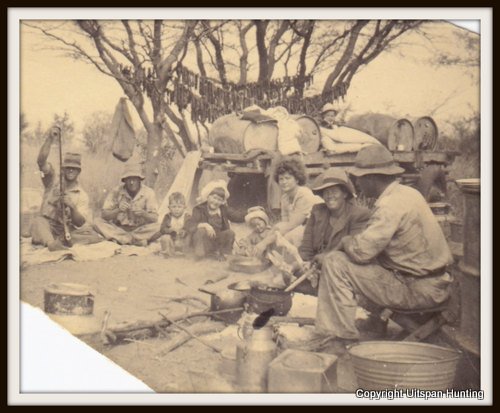
(Picture above of our ancestors.)
Did you know?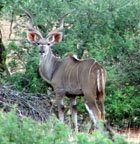 Greater Southern Kudus are famous for their ability to jump high fences. A 2 m (6.56 ft) fence is easily jumped while a 3 m (9.84 ft) high fence is jumped spontaneously. These strong jumpers are known to jump up to 3.5 m (11.48 ft) under stress. |
Did you know? Some animals have one sense more than man!The flehmen response is a particular type of curling of the upper lip in ungulates, felids and many other mammals. This action facilitates the transfer of pheromones and other scents into the vomeronasal organ, also called the Jacobson's Organ. Some animals have one sense more than man!The flehmen response is a particular type of curling of the upper lip in ungulates, felids and many other mammals. This action facilitates the transfer of pheromones and other scents into the vomeronasal organ, also called the Jacobson's Organ.This behavior allows animals to detect scents (for example from urine) of other members of their species or clues to the presence of prey. Flehming allows the animals to determine several factors, including the presence or absence of estrus, the physiological state of the animal, and how long ago the animal passed by. This particular response is recognizable in males when smelling the urine of a females in heat. |
